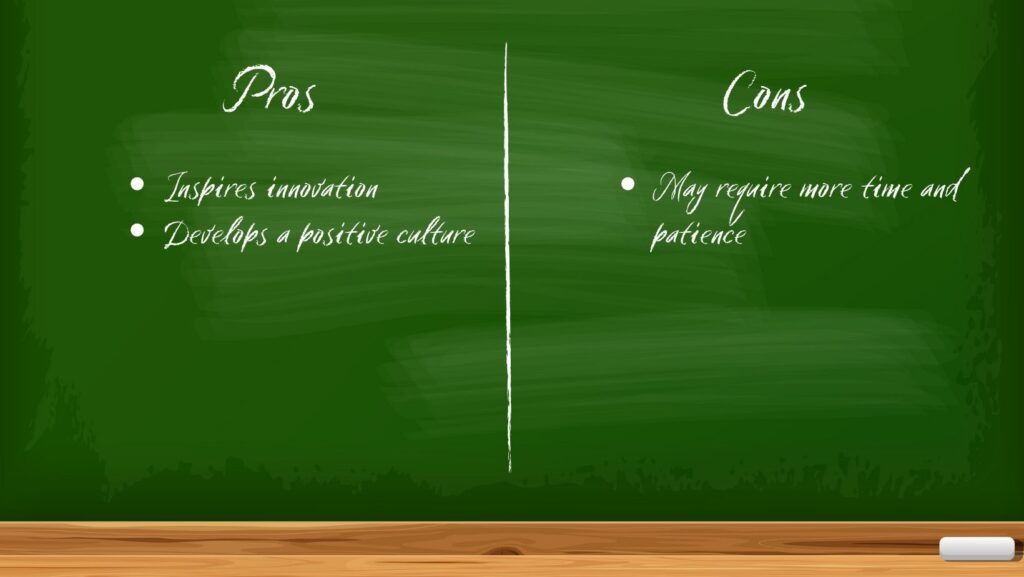Effective leadership hinges on understanding and implementing the right management style for various situations. In the US, for instance, around 35% of workers think company culture is an important factor in joining an organization.
This article explores the diverse landscape of management styles, providing insights into what management styles are and when to use them.
Discover five prominent management styles—Autocracy, Consultative, Delegative, Persuasive, and Transformative—and gain valuable knowledge on their overviews, application methods, pros, and cons.
What Are Management Styles?
Management styles refer to the approaches and techniques that leaders employ to guide, motivate, and direct their teams. Each style comes with its own set of principles, communication methods, and decision-making processes.
By understanding the nuances of different management styles, leaders can adapt their approach based on the needs of the team and the organizational context.
5 Types of Management Styles and When to Use Them
Explore the versatility of management styles with these five distinct approaches and gain insights into when and how each style can be optimally employed within diverse organizational contexts.
| 👉 Helpful Article: Leadership Tips for Managers: 20 Effective Ways to Lead Your Team |
Autocracy
Autocratic leadership involves a single decision-maker who holds significant control over the team. Decisions are made without much input from team members, and communication tends to be top-down.
Although many studies have found that autocratic leaders can lead to low job satisfaction, a survey still suggested that 21% of employees prefer autocratic leadership.
This style is effective in situations that require quick decision-making and clear directives. It’s particularly useful in crisis scenarios or when a leader possesses specialized knowledge.

When to Use?
Autocracy is suitable in emergencies, hierarchical structures, or when immediate decisions are essential.
Consultative
Consultative leadership values team input before decisions are made. While the leader ultimately decides, team members’ perspectives are considered in the decision-making process.
This style is beneficial when diverse viewpoints are valuable. Leaders actively seek input before making decisions, fostering collaboration.

When to Use?
Consultative management is effective when addressing complex challenges, encouraging team buy-in, or promoting innovation.
Delegative
Delegative leadership entrusts decision-making to team members. The leader provides guidance but allows the team to make significant choices independently.
This style empowers team members to take ownership of their work. Leaders delegate tasks and decision-making authority, promoting autonomy.

When to Use?
Delegative management is suitable when team members are skilled, motivated, and capable of independent decision-making.
Persuasive
Persuasive leadership involves the leader selling their vision and decisions to the team. The goal is to inspire commitment through effective communication.
Leaders using this style excel in communication and persuasion. They articulate their vision convincingly to align the team with organizational goals.

When to Use?
Persuasive management is effective when implementing significant changes, fostering a shared vision, or overcoming resistance.
Transformative
Transformative leadership aims to inspire positive change within the team and organization. Leaders using this style focus on empowering and developing their team members.
Leaders employing a transformative style prioritize mentorship, development, and creating a positive organizational culture. They foster innovation and encourage personal growth.

When to Use?
Transformative management is effective when aiming for long-term organizational growth, building a positive work environment, and developing a highly motivated team.
Factors to Consider When Choosing a Management Style
Selecting the most suitable management style requires careful consideration of various factors:
- Task Nature: Consider the complexity—creative tasks may benefit from a participative style, while routine ones might need a more directive approach.
- Team Skills: Assess team strengths and weaknesses to match the management style with their abilities and motivations for enhanced productivity.
- Urgency: Urgent situations may require an authoritative approach for swift decisions, while less pressing matters allow for more participative styles.
- Organizational Culture: Align the chosen style with the existing culture to ensure smoother integration and acceptance among team members.
- Adaptability: Maintain flexibility to adapt management styles according to evolving circumstances for optimal outcomes.
Signs You’re Using the Right Management Style
Recognizing the effectiveness of a chosen management style involves observing certain indicators. Signs of a successful management style include high team morale, enhanced productivity, effective communication, and the achievement of organizational goals:
- High Team Morale: A positive and motivated team, showing enthusiasm and engagement in their work, often indicates the suitability of the management style. To measure this, check out this article on how to measure employee engagement.
- Enhanced Productivity: Increased efficiency and productivity among team members are signs that the management style is fostering a conducive work environment.
- Effective Communication: Clear and open communication channels within the team, minimizing misunderstandings and promoting transparency, indicate a successful management style.
- Goal Achievement: When the team consistently meets or exceeds organizational goals, it signifies that the management style is driving results effectively.
- Regular Assessments and Feedback: Continuous assessment and feedback loops ensure leaders can adapt their style to better fit the team’s needs and align with the organization’s mission.
Reflection: What Is the Best Management Style?
As a leader, understanding your management style is crucial for creating a positive and productive work environment. Reflect on your strengths, weaknesses, and natural inclinations as a leader.
Consider seeking feedback from team members to gain insights into their preferences and expectations. Strive for a dynamic approach that allows flexibility in adapting your style based on evolving circumstances and team dynamics.
In conclusion, effective leadership involves mastering various management styles and deploying them judiciously. The journey to becoming an adept leader is ongoing, requiring continuous self-reflection, learning, and adaptability to meet the evolving needs of the team and the organization.

Hi, I’m Mira! I’m a passionate content writer and editor, mostly working on SEO. Being in the biz for nearly three years now, I have an extensive understanding of productivity tools and the users’ needs. These first-hand experiences help me directly connect with the users’ sentiments, translating them into compelling content for audiences across a wide range of industries.
